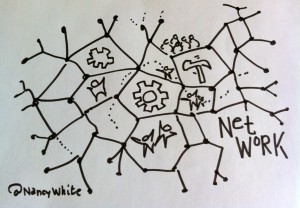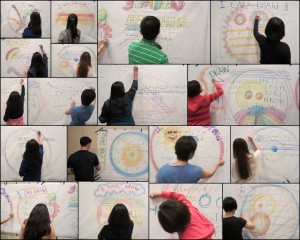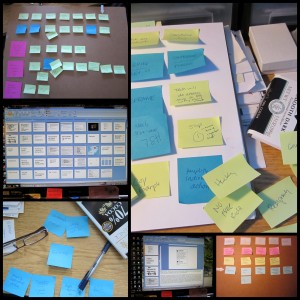I just had to share these – they are so cool from TabJuice. They were some of the inspiration for my KM Singapore talk last week! Transpose them out of a commerce setting to other group settings… lots of ideas!
Speaking of Resilience
 As I just posted today about resilience in terms of the strategic applications of communities and networks (the people kind), it was a lovely bit of kismet that today’s OLDaily had a link that again brings this idea to the fore.
As I just posted today about resilience in terms of the strategic applications of communities and networks (the people kind), it was a lovely bit of kismet that today’s OLDaily had a link that again brings this idea to the fore.
Infrastructure Resilience ~ Stephen’s Web.
One thing that Stephen brings up is the importance of redundancy for resilience and how that may be counter to efficiency, the beast that seems to rule everything these days. The key is looking at the bigger, longer term context.
The direct link to the article he is referencing is Infrastructure Resilience, from Valdis Krebs.
KM Singapore Recap
Last week I had my first trip to Singapore and was a keynote speaker and workshop presenter at KM Singapore. My talk was entitled “The Heaven and Hell of Communities!” If you want the short version, a 2 minute recap can be found here. (I just blogged about the Graphic Facilitation workshop as well.) I want to thank the fabulous Edgar Tan, Wai Kong and Patrick Lambe of Strait’s Knowledge for hosting me. You guys ROCK!
I spent quite a bit of time thinking about this presentation, so I thought I’d share some of that process, acknowledge and thank those who helped me, and then share the slide set.
Process
My first instict was to use my communities and networks to “think out loud” about the tensions that are mounting in the productive and strategic use of communities and networks. Little did I realize that I was actually setting myself up for the very challenges I was trying to talk about. Filter failure. Lack of discrimination and strategy in how I tapped my networks. Too much on my plate. Mama mia. It was all in front of me, and I wasn’t even seeing it.
My first round was asking on Twitter for “radical ideas” about knowledge collaboration. Then I set up a Google Doc to start sharing my ideas and solicit comments. THEN I added one more mechanism, Google Moderator (which it turns out, I’m not so fond of) which gave me more diverse input. Then I started scanning more generally on my network and the “kismet” factor kept turning up more and more interesting and relevant links. These are still a disorganized mish mash on the Google doc. I think I’m not such a great Curator! (Robin, now you know why I was massively inarticulate on this topic when we last talked in Rome!) Thanks Jennifer, Dave, Eugene and Christopher and the rest of my network!
I was pretty darn well overwhelmed, so I let it all sit. Then a week before I was due to travel, I started with my “post it note” presentation planning, pulling out three main thoughts, supporting information, key anecdotes and at least 2 actionable suggestions for each main point. I begin to feel urgent, so I started dumping things into PowerPoint, with the intention of drawing the visuals for the slides once I had them set. But they just would NOT SETTLE in my mind or on the screen. So I decided to travel with things “unfinished.” Sometimes at the event, in the PLACE things fall into place. But I could not chase away some niggling worries.
I got a bit nervous as things had not fallen into place. Then the night before the keynote they did. David Weinberger’s keynote on day one totally resonated with what I wanted to talk about. Patrick Lambe’s talk analyzing the incident review of a major breakdown in Singapore’s public transit system told the perfect story validating the three points. In fact, almost every talk had a resonate point or reference. And somehow the language around the points got clearer as I reread some of my favorite work of friends. The idea of resilience instead of mitigation, of creative destruction to make room for strategic participation in communities and networks, and of conversations that matter all felt right.
As an aside, here are my Sketchnotes from some of the other presenters!
[slideshare id=14227608&doc=kmsingapore2012sketchnotes-120909221148-phpapp02]
Slides
The room at the Swissotel was pretty bright and images on previous slide sets were washing out. I usually use visually oriented slides – either photos or my own drawings. I realized a simple, bold text strategy might be better in this room, so that actually saved me some prep time. I rarely use text, but I think this worked out OK.
I was surprised how popular the slides were on Slideshare, even without any notes or narration. I was featured on Slideshare one day! Now I need to get the audio/video so there can be a bit more sense making.
[slideshare id=14196396&doc=heavenhellofcommsnetsfinalkmsg12-120906192628-phpapp02]
Feedback
The room seemed to feel some resonance with the messages. The group was fairly quiet through the whole two days of the event, so one would not expect whooping and shouting, but the follow up questions were very thoughtful and we continued some of these in the afternoon “Knowledge Market.” The three time horizons from Steve Waddell, the ideas I borrowed from the sustainability field around resilience instead of just mitigation and the chance to STOP doing something resonated. Patrick and I now want to work more on practices for creative destruction! Stay tuned for a workshop series.
All in all it was great fun.
Related Links and Event Artifacts
- KM Singapore blog with lots of social reporting artifacts from the event.
KM Singapore Graphic Facilitation Workshop
 It makes no sense to fly all the way to Singapore just for a keynote, so the good folks at Straits Knowledge and IKMS set me up to offer a graphic facilitation pre-conference workshop prior to KMSingapore (#KMSG). 12 folks joined me to explore how we productively use visuals as we facilitate in our work. After some visual introductions, we did the classic “I Can Draw” exercises, then worked on basic visual vocabularies. With that under our belts, we explored how we can use these visual skills in a variety of facilitation settings. You can see the full agenda here. Below are some images from the workshop, including our use of the visual practice “river of life” as a workshop evaluation tool.
It makes no sense to fly all the way to Singapore just for a keynote, so the good folks at Straits Knowledge and IKMS set me up to offer a graphic facilitation pre-conference workshop prior to KMSingapore (#KMSG). 12 folks joined me to explore how we productively use visuals as we facilitate in our work. After some visual introductions, we did the classic “I Can Draw” exercises, then worked on basic visual vocabularies. With that under our belts, we explored how we can use these visual skills in a variety of facilitation settings. You can see the full agenda here. Below are some images from the workshop, including our use of the visual practice “river of life” as a workshop evaluation tool.
[slideshare id=14227986&doc=graphicfacilitationworkshop-120909230832-phpapp02]
Resources
“This isn’t what I thought it was: community in the network age”
Earlier this year some of my online friends (Val Cortes, Lisa Endersby and Ian Simmie) invited me to be part of a panel they were preparing for Canadian Association of Colleges and Universities Student Services Conference: Engaging Digital Citizens <http://www.cacuss2012.ca> in Vancouver BC, Canada. The topic was on communities and learning, building off of some lessons learned from the project the three of them had been doign.
Abstract
What does it mean to be a member of a community in the digital age? In this session you will begin to explore how student affairs professionals can use available technologies to create vibrant and engaging online communities. Through discussing the SASA Leadership Educators Resource Network (LEARN) online community as a case study and the lessons from the LEARN membership survey, we will explore the creation and facilitation of this and other distributed work, learning, and community groups.Summary
Developing and maintaining a vibrant and meaningful online community requires purposeful care and nurturing. Many of the tools that student affairs professionals use in their daily practice can be applied to the digital world. In this session, we will review the theory of online community facilitation and we will provide specific group facilitation tools, strategic-planning models and engagement strategies that participants can implement in their own contexts. Finally, we will share the lessons that we have learned as LEARN facilitators and creators. The session will feature a remote presentation with a colleague in Victoria and, potentially, with a Seattle-based consultant and international online group facilitator of distributed work, learning and community groups.
To warm things up, Lisa Endersby wrote this blog post. My job was to add something about this ecosystem of group forms that address the diversity of small groups, individuals, bounded communities and networks. I’m particularly interested in the interplay between communities and the broader networks they live in and “by.”
This was all well and good, except due to my not paying close attention to dates, I was not available to do something live online with them as I was going to be, ironically, driving to Vancouver for Northern Voice and the Online Community Enthusiasts gathering. So we decided that I’d record a short piece for them to weave into their presentation. This makes life easy for me in terms of preparation, but dang, I sure missed the interaction!
Then the F2F team was going to ask the participants some questions. I’m reposting them here because they continue to be useful questions. Every time I engage in a conversation about communities, communities of practice, networks, groups — whatever form — we run into a lack of clarity of what we are talking about.
- What is your definition of community?
- How do you know when/if you are a part of a community? How do you know when/if you aren’t part of one?
- Can you join an online community (‘obtain a membership’)? What does this look like?
- What is your first reason/goal for entering an online community?
- Are there any risks to being part of an online community?
- What are the benefits of online communities? Which one(s) resonate(s) most with you?
As I prep for some presentations and workshops at KMSingapore next week, these questions remain alive, along with the question “how do we useful work with profusion of networks, groups and communities we MIGHT belong to?” What are the strategic choices and practices? Stay tuned for more…

